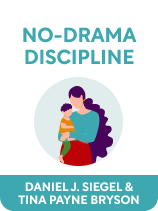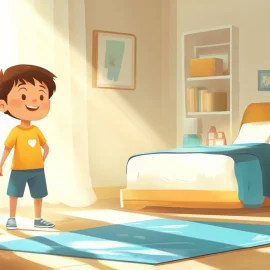

This article is an excerpt from the Shortform book guide to "No-Drama Discipline" by Daniel J. Siegel and Tina Payne Bryson. Shortform has the world's best summaries and analyses of books you should be reading.
Like this article? Sign up for a free trial here .
What does it mean to redirect children’s behavior? What three strategies can you use to teach your child to behave appropriately?
The book No-Drama Discipline explains the three steps to properly discipline your child. Step three is all about teaching (or redirecting) your child’s behavior. The authors provide three methods for doing this: notice—don’t criticize, create a dialogue, and try a conditional “yes.”
Here is how to teach your child to follow the rules.
Discipline Step 3: Redirection
After connecting with your child, the final step in Siegel and Bryson’s method is teaching (or what they call redirecting children’s behavior). Teaching involves setting and reinforcing firm boundaries—in other words, teaching children what behavior is and isn’t okay—but doing so in a loving way that prioritizes your connection with your child. (Shortform note: Even though the authors call this step “redirection,” we’ve changed it to “teaching” to better reflect two of the authors’ ideas: First, that discipline should be about teaching, rather than punishment; and second, that discipline should focus on building long-term skills rather than just redirecting a child from one behavior to another in the moment.)
So what happens when your child breaks a rule? According to the authors, the first thing you’ll teach is why your child’s behavior was inappropriate. When your child understands why their behavior was wrong, they’ll experience natural feelings of guilt and regret. Those are uncomfortable feelings, and when that discomfort is paired with misbehaving, kids will naturally learn to avoid misbehavior so they can avoid feeling bad.
(Shortform note: You may be wary of letting your children feel these negative emotions for fear of damaging their self-image. However, in Daring Greatly, shame expert Brené Brown argues that there is a difference between guilt (“I’ve done something bad”) and shame (“I am bad”), and it’s the latter emotion that’s more likely to impact self-image. Brown believes that guilt doesn’t have to lead to shame—instead, it can be a healthy experience that teaches children to separate their behavior from their identity. Therefore, Brown agrees with Siegel and Bryson that allowing children to feel guilt is important for their development and won’t harm their self-image.)
Siegel and Bryson believe that teaching, when done well, leads to three positive outcomes for kids: increased understanding of their own emotional reactions, empathy for others, and practice making amends and repairing relationships.
(Shortform note: Effective discipline leads to another important positive outcome that the authors don’t mention: Namely, discipline helps children feel safe. This is because discipline shows kids that you are in charge and they don’t have to worry about making adult decisions yet.)
Strategies for Teaching
Here are three strategies Siegel and Bryson recommend for teaching your children how to behave appropriately and follow the rules:
Teaching Strategy 1: Start By Noticing, Not Criticizing
Instead of jumping straight to criticism when your child misbehaves, the authors recommend you start by describing what you see and asking your child to explain it to you. For example, if you see gum in your preschooler’s hair, you might say, “I see gum in your hair; how did that happen?” instead of yelling, “What did you do to your hair?!” This strategy directs children’s attention to their misstep without making them feel attacked.
(Shortform note: Why is it important not to make children feel criticized or attacked? Siegel and Bryson don’t say, but research shows that parental criticism can have long-term negative effects. Children who are frequently criticized by their parents learn to ignore other people’s facial expressions (to protect themselves from seeing the disappointment or anger on their parents’ faces). This, in turn, impairs their ability to form relationships and can even make them more vulnerable to depression and anxiety. Therefore, discipline strategies that avoid criticism can protect children’s mental health in the long term.)
Teaching Strategy 2: Create a Dialogue
In addition to asking kids to explain what happened or what they were feeling when they misbehaved, Siegel and Bryson advise asking them to help you come up with a solution. This gives their upper brains practice understanding the consequences of their behavior and coming up with solutions. They’ll also feel more respected throughout the process if they know you value their input—even if they don’t like your ultimate decision.
(Shortform note: Siegel and Bryson don’t explain why kids tend to cooperate more when they’re involved in the discipline process, but it may have to do with control. Nutritionists have noted that picky eaters tend to be more willing to try new foods when they help prepare the meal because they feel more in control of the situation; the same process might be at play when kids have a say in discipline.)
Teaching Strategy 3: Try a “Conditional Yes”
Instead of responding with a hard “no” when your child asks for something, the authors recommend saying “yes”—but on your terms. For example, if your child wants to wear their astronaut costume to school, you might say, “Yes, you can wear your costume when you get home this afternoon” instead of an outright “no.” Hearing a flat “no” tends to activate children’s lower brains, so using a conditional yes instead can help avoid drama.
(Shortform note: Why do children perceive “no” as a threat? The authors don’t explain, but it may be because children hear a constant litany of “no” from the moment they start to interact with their environment. As a result, their brains form a very primal connection between the word “no” and the uncomfortable feelings of being scolded and having their goals thwarted.)

———End of Preview———
Like what you just read? Read the rest of the world's best book summary and analysis of Daniel J. Siegel and Tina Payne Bryson's "No-Drama Discipline" at Shortform .
Here's what you'll find in our full No-Drama Discipline summary :
- Ways to empower parents to discipline their children without the drama
- Why you should discipline mindfully, with the goal of connecting with your child
- How to teach your child why a behavior is unacceptable






